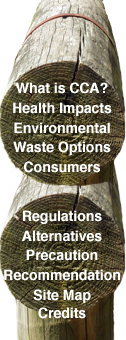Waste Options
Volumes
The scale of the waste-treated timber is enormous, particularly if existing CCA-treated timber structures are to be replaced by safer alternatives, as this report recommends. However there are already large amounts of waste CCA-treated timber being produced annually in Australia and overseas. A major source of this is the wine industry.
In 1999, a report prepared for the South Australian Environmental Protection Authority (EPA) found that wineries were the largest purchasers of preservative CCA-treated timber in South Australia. They estimated that 75% of the approximate 60 to 120 million vineyard stakes were made from CCA-treated timber. The SA EPA has found the growth of the wine industry has paralleled the increase in CCA timber manufacture. Since annual stake damage is around 15%, it is anticipated that in 2024, a peak volume of between 8 and 16 million posts will require disposal (cited in Smith and Mollah, 2004). There are already 816,000 posts stockpiled (Bell, 2005). The South Australian EPA warns that a toxic disposal crisis is looming, with ‘no acceptable disposal option for CCA’ in SA and no life cycle management for the heavy metals in the CCA. One way of easing the waste problem would be to encourage the wine industry to change its material choice for vineyard stakes. (Scott, 2004).
A treated timber disposal crisis is already being experienced in California. San Joaquin grape-growers turned to other crops after several difficult seasons, and removed thousands of tonnes of CCA-treated stakes. They are not permitted to burn these due to air pollution risks, and disposal to a landfill is not only costly but brings with it the ‘lifetime liability’, as disposer identities are logged and they can be held responsible in the event of ensuing problems at the landfill site (Pollock, 2004).
Matthew Warken (2004: 44) notes in his Masters thesis on wood waste in Sydney that “there would still be treated timber in the waste stream for the next 10 – 25 years, even if CCA treatment was banned today”.
References:
Bell, F. (2005), ‘Managing Treated Timber Vine Posts’, paper present to 3rd Australian Wine Industry Environment Conference, Adelaide, February.
Pollock, D. (2004), ‘Arsenic and Old Stakes: Too dangerous to burn or bury, treated wooden grape stakes sit in piles of thousands’, FresnoBee.com, California, October 10.
Scott, G. (2004), ‘CCA Treated Timber: A Problem?’, WMAA Towards Zero Waste Conference, Australia, April.
Smith, T. And Mollah, M. (2004), ‘CCA Review Implications For Viticulture’, The Australian & New Zealand Grapegrower And Winemaker, Ryan Publications, April.
Warken, M. (2004), ‘Optimal Recovery of Resources: A Case Study of Wood Waste in the Greater Sydney Region’, Master of Engineering Research Thesis, Chemical Engineering, University of Sydney, March.


